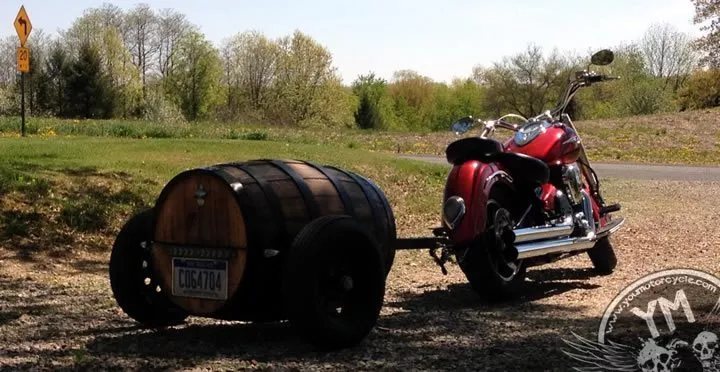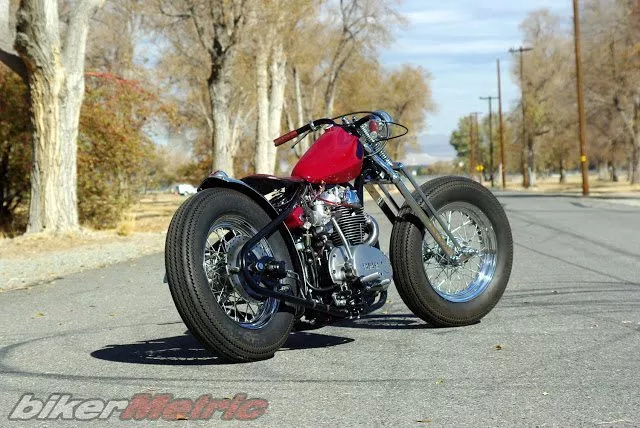welcome back to bikerMetric, mofos. here is the latest techTip from our resident mad mechanic, hugh owings. he’s going to show you how to properly re-build and re-assemble your xs650 transmission, for those of you in need of doing so for your three-decade-old yamaha motorbike.
the information is perfectly laid out and there are a few dozen photos to illustrate every step. as i edited this article, i realized, “hey, i could do this!”
if i can, you can. have fun!
All right folks, last month we left off with a freshly built re-phased XS650 crankshaft. Well, that crank has long since been shipped to the owner where it’s hopefully tearing up the streets and being a menace to the vintage bike enthusiast crowd.
That’s not to say I don’t always have something going on here at Hugh’s HandBuilt to keep your mind alive and help convince you to get your hands dirty. Today I have an engine that is a very special build. It is from a very early XS1, and we are updating it with re-phased guts, 447 rods, a 750cc big bore kit, updated cam chain system, late model transmission, and fifth gear overdrive, along with a few other little tricks to bring it up to par. Some of the differences in this particular set of cases will be noticeable to the naked eye right away.
The most noticeable difference is there is no location for an electric starter. Some of the stud locations are very different and there are more bosses and cast-in webbing for extra strength. Other interesting differences? There are more machined oil passages for the transmission and the cases suggest 3000cc of oil, while later models suggest much less. Once I had these cases stripped, I noticed a funky yellow stain on the alloy. There is a rumor that this engine might have been used in the Flat Track racing circuit and given the amount of repair these cases required, I believe it.
For those of you with a more common XS650 engine, don’t worry, everything you read here applies to your build!
Now you have a really clean and nice set of cases ready for that crank you built, right? If not, don’t read the rest of this article because you can’t build a great engine with sub-par effort. Nasty engine cases are a sure fire sign of a poorly built engine. Take pride in your work. Now that we have that out of the way and you’ve got a set of perfectly cleaned cases, you should have something like the photo above, ready to go.
The owner of this engine wanted his cases coated in high-temp low gloss black. If you decide to paint your cases, make sure to tape off all sealing surfaces prior to painting. If you think a “rattlecan rebuild” is the ticket, forget about it. Painted gaskets, bolts, and grime are a quick giveaway to a “rattlecan rebuild” and you aren’t fooling anybody. Take the time to clean all the threads on your engine before installing the first component. There is a good chance your case studs look a lot like this:
Rusty and corroded threads must be cleaned up before you can try to properly torque any hardware. If you are like me and live in an area where specialty tools are hard to find, you might make your own. I don’t like waiting on special tools to come in the mail so I make what I need. Today we have a cool little trick.
I need to clean the stud threads on these cases. They have several years of crud, crust, and paint on them. I will chase them with an M8 1.25 die.
Doing this job with a standard die holder sucks and takes an incredible amount of time. Instead, grab a socket that your die just barely fits into. Go to your drill press and drill a hole suitable for a small set screw. I used a 3.3mm drill and tapped 4mm x .70 threads since I keep that size set screw in stock for my fork lowering kits. Use what you have, it’s a tool after all, and no, this won’t hurt your socket but I would choose an inexpensive brand socket before drilling into my Snap-On goodies.
Keep enough room inside the socket for the longer threads on the studs by locating your die near the end of the socket like this:
I’ll assume that since you’ve made it this far, you’ve decided to do things properly. Good for you, the world needs more properly built bikes and there is nothing that feeds the HD crowd with higher-octane fuel for the hate fire than a broken down *** bike. Since we are cleaning the threads, get some oil to keep the die running smoothly over the threads. Remember, we aren’t cutting new threads, just cleaning up the old ones. I do a lot of machining and tapping so I usually have some tapping fluid around. If you don’t have any, a little bit of Marvel Mystery Oil and automatic transmission fluid works wonders as well. If you don’t know what Marvel Mystery Oil is, fart loudly at Christmas dinner with your parents. It’s what they get for not teaching you very important things in life.

Always start your taps and dies by hand. Not doing so will surely wreck your threads and your neighbors will likely learn the extent of your five or six-word verbal communication skills with inanimate objects. Not that it won’t happen at some point, because I’ve been there plenty of times, but don’t be in a hurry. It saves time and energy to do things right at the outset, and then you won’t be cursing a defenseless engine and throwing tools into the darkest corners of the shop to never be found again. Find your engine building mojo and have fun with this stuff.
Once you have your die started by hand, feel free to use a socket wrench to speed up the process. Once you are done chasing the threads on the studs, clean all the oil off with some brake cleaner or such. You’ll want these studs perfectly clean for the Loctite you’ll be using later.

Now that you’ve got that over with, you’ll want to get a good M6 x 1.00 tap. For this kind of job, I prefer a four-flute bottom tap. You’re gonna be at this for a while, so grab a cold one and remember, don’t rush.
There are a few other threaded holes in the cases you’ll want to clean out, but by now you’ve got the idea and I don’t need to guide you through all that. Just make sure all your threads are clean and good to go. Recheck everything at this point to be sure.
Now onto the good stuff….
This transmission is getting a nice little upgrade. A fifth gear overdrive is available from Mike’s XS for later model transmissions. We are swapping the transmission from an 1980 model into this engine and are good to go. If you are not changing the fifth gear on your transmission, keep reading and we’ll get to installing the transmission just like a stock one.
Pull the bearing and shims off of the transmission input shaft. We are removing the 2nd gear from the end of the shaft. You’ll need to remove a snap-ring while you are at it.
Slip off the stock fifth gear. This is the only part getting changed to upgrade your transmission.
Keep track of the various shims and snap-rings. They will reinstall in order from top to bottom from this picture:
This your new fifth gear. It looks similar to the stock gear but with a different tooth count. I’ve run one of these gears for thousands of miles, so have no worries about their quality. There is no noise difference, and lowering your cruising RPM is nice for many reasons. Or, if you are a speed junkie like me, you can run some deep gearing for triple-digit speeds!
Reinstall all the parts.
Take the top engine case and lay it down on your workbench. I remove the engine studs on all my builds, so this step will be a bit difficult if you have not done so. You can get away with shimming the case up off the studs but having the top case upside down is a must for the proper installation of the transmission and crankshaft.
Align your transmission gears with the shift forks and drop them in. Make sure to line up the cir-clips into the grooves on the cases. I have pointed out the clips here with my Sharpie:
Once you have installed the transmission, run it through all the gears and make sure you’re happy with it. Now you are ready to start setting the seals in place. I use only genuine Yamaha seals on my builds and get them locally through an independent moto shop. They cost the same as the non-OEM **** you can get from Mike’s XS. Support your local shops. They need you and you will need them at some point. It’s always good to be a familiar face in your local motorcycle shop [editors note: from personal experience i know hugh is right].
Now this particular seal is a total pain the *** if you choose to install it after you have the cases together. They constantly leak and get mangled to death if you try to install one without the cases split. Save yourself some time and install the seals now while your cases are apart.
Early Yamaha XS650 engines came with a one-piece clutch rod. If you don’t have one, go get one. They are available from popular XS650 suppliers. They have smoother clutch action, less leaks which makes them $16 well spent! This one is a bit beat up, and is being used only as an example for this techTips. A new one is on the way.
This is the most critical part of your bottom end build. The locating pins are crucial in making sure your crank gets the oiling it needs to stay alive. I’ve indicated the pin here with a yellow paint pen.
On this bearing race, you can see two lines. These will line up with the case mounting surfaces. I went ahead and marked them yellow so I could see them while I was working. Your crank will have three of these bearings with two in the middle of the crank. Lining these bearings up is critical. As always, take your time and make sure they fit properly.
The large main bearing on the crankshaft will sometimes have marks that line up with the cases, but not always. Don’t be in a hurry to locate them, if they exist, and put some defining marks on the bearing for reference. If you have to, pull the bearing off the crank and install it by itself in the cases and make your marks. It’s worth taking the time. Trust me on this one. I see more dead cranks and burned up engines from folks not doing these steps properly.
Slowly line up all four bearings in their journals on the engine case. Don’t force anything to fit. When they are in the right position, the crank will drop into place.
Leaving a little bit of room on the edge of your workbench for the rod ends to dangle will keep the crank from wanting to pop up while getting the bearings aligned.
Spin the crank a few times to make sure all the bearings are seated. Double check all your marks. Once you have the crank bearings fully seated, take a break. Eat a sandwich. Smoke your cancer stick. Drink a beer.
After a little breather, get some lube and put it on the transmission gears as well as on the big end of the rods. I use Lucas, because it won’t run all over the place while I’m building the engine.
We are now ready to put the cases together. I like to use Hondabond on my Yamaha engines. I’m weird like that. Make sure you use something similar but do not use a thick gasket sealer.
Here is a great tip; make sure you put Hondabond on all of the case mating surfaces. These locations typically cause leaks from the bottom of the engine as oil follows the studs. By sealing all the stud locations, you won’t need those pesky copper sealing washers. More on that in a bit…
Apply some Hondabond to all of the machined mating surfaces of the crankcases. A little bit goes a long way and I usually blend it out with my finger as I go. The nice thing about these sealers is that you don’t have to worry about “squeeze out” if you use too much. It will not break loose and cause a ruckus in your engine like normal sealers.
As you may see below, I like to add an extra bit of sealer around the bearing edges and seal edges to be sure I won’t get any oil leaks. Once you have all your sealer on, you want to move fairly quickly with the next few steps, so put the beer down!
Since I was working alone on this project, it was tough to get a picture of putting the two case halves together. It’s not rocket science. Simply line up the studs, make sure the locating dowels are in place and drop the bottom case onto the top case. Do not force the cases together! If they don’t easily fit, you have a problem.
I like to use all new hardware for these builds. Since we put sealer on all the stud locations, we no longer need to worry about the copper sealing washers under some of these nuts, as I hinted above, and you won’t be losing hardware as others do on a stock engine. Nice touches like this create a long-running, non-leaky engine.
Make sure all of the studs get new stainless washers and nuts. I install the washers and then add a drop of Blue Loctite or Loctite Threadlocker to the studs.
Torque all the nuts down to the specific torque as described in your manual and yes, you need a manual, so get one. Don’t forget that hidden nut and stud behind the clutch basket or the ones behind the final drive sprocket. They are often overlooked.
Flip the engine over and install new bolts in the remaining locations. If you are using stainless hardware, always put a dab of Anti-Seize on the threads. Stainless and aluminum do not like to dry hump, so lube it up!
Torque those suckers to specs and you are done!
Next month we will look at a few other cool upgrades you can do to the bottom end of your XS650 engine. Until then, stay in the shop and get creative!
+ + +
Thanks, Hugh. Like last time, this was informative and well-documented with more photos than a stick could shake itself at. My stick is a stump after this one. Now how am I going to keep those punk kids off my lawn?
Remember folks, if you get stumped (ha, that was funny), need tech advice, or want to buy lots of Hugh’s world famous parts and services, visit his blog, check out his website, or simply email hughshandbuilt at gmail.com.
Peace out and thanks for stopping by.

Get the best of bikerMetric directly in your inbox, once a week, every week.
[wysija_form id="1"]
 bikerMetric custom metric bobbers, choppers, and cafe racers by honda, yamaha, kawaski, and suzuki
bikerMetric custom metric bobbers, choppers, and cafe racers by honda, yamaha, kawaski, and suzuki










![[bottom tapping joke goes here]](https://4.bp.blogspot.com/-DvFh5AD5zqo/TukdENJC60I/AAAAAAAAGRM/Gry4IjSNKgA/s1600/bottom-tapping.jpg)

































I’m smiling HUGE here up in the Great White North Hugh.
Cold winter nights, I love looking/reading your web pages.
Thanks eh
F.G.C. & I.G.C.
Hugh, I love this article. Check out some link love I shot you from my site: http://www.motorcycleinsurance.com/choosing-your-winter-motorcycle-project-and-the-guys-who-can-help/. Keep up the awesome articles and the photos are what make them intelligible to a layman like me…
Man, I hate to whine about **** I’m getting for free, but… what happened to “Next month we will look at a few other cool upgrades you can do to the bottom end of your XS650 engine”? Did I miss something? I kinda want to read that article, but it doesn’t seem to exist. I know Hugh is busy, but thats what you get for doing good work.
exactly, marv. it’s christmas time for the motorcycle world right now. plus, he’s really good at what he does and i take great pride in helping him be too busy to send me a new post.
it will come. but probably in another couple weeks, at best.
feel free to hit him up at his website and tell him “WTF!” that would be great.
hi!
im about to close my xs650 crankcase and, even in haynes or clymer manuals, they say to use 2.2 m-kg (clymer), or 2.0 m-kg(haynes), to close the crankcase. isnt it a weak tightening torque? how much did you use to close it?